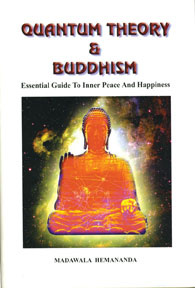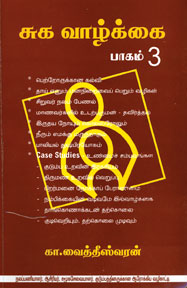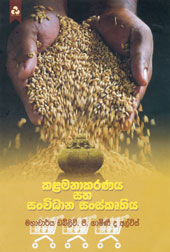|

Scientific approach to understand Buddhism
Reviewed by R. S. Karunaratne
"Quantum Theory and Buddhism - Essential Guide to Inner Peace and
Happiness"
Author: Madawala Hemananda
Buddhist Cultural Centre, Nedimala, Dehiwala
Price Rs. 600
"Quantum Theory and Buddhism - Essential Guide to Inner Peace and
Happiness" is a timely and refreshing book. It is an invaluable addition
to the growing number of English books on Buddhism.
The book is pregnant with incisive lateral thinking and it sheds new
light into many doctrinal areas of Buddhism. The author has taken care
to include new ideas and concepts with elegance and style. He has
discussed the latest scientific research backed by relevant examples.
 The
title of the book "Quantum Theory and Buddhism" does not require the
reader to have a comprehensive understanding of the concept. If you have
a general understanding of science that will suffice to read and
understand the book. The
title of the book "Quantum Theory and Buddhism" does not require the
reader to have a comprehensive understanding of the concept. If you have
a general understanding of science that will suffice to read and
understand the book.
In the modern world everybody is expected to have at least a nodding
acquaintance of science. The author has made the reader's task easy by
relying on the readily understandable aspects of the quantum theory.
Using many theories found in Buddhism and science, the author has
tackled some of the age-old questions for which we have been trying to
find answers. Some of the questions are: Where did we come from? Is
there a purpose of our life on earth? Who or what are we in reality?
Where do we go from here?" Can Buddhism and quantum theory supply the
answers to these questions?
The most intriguing new concept that recurs throughout the book is
that human beings and everything else, material and immaterial, are only
"temporary dancing (oscillating) patterns of visible energy', devoid of
a fixed entity at the core.
This energy comes from the only source in the cosmos, the 'quantum
vacuum', the vast empty space, packed with unexcited microscopic
particles, which is constantly creating energy by converting unexcited
particles into excited particles.
Reluctantly though, it says that the scientific community has now
acknowledged the possibility that even the 'big bang' could be a
fluctuation of the quantum vacuum. This energy, of course, is
responsible for all forms of life on earth including humans.
The author identifies this energy component from the quantum vacuum
that resides within each one of us as, 'the quantum body consciousness
vibrating in its own unique frequency'.
The 'quantum body consciousness' is described, among its other
attributes, as the embodiment of 'true love' and in its original state
of purity unsullied by karma, it is the ultimate repository of universal
compassion.
'Unique frequency' is central to the discussion that living matter,
from the smallest microbe, the paramecium to the most sophisticated
human being, operates in a frequency unique to that living being.
Both empirical, and scientific evidence are adduced to substantiate
the existence of this unique frequency, which in turn is utilised to
explain the operation of karma (intentional actions), the energy that
takes life from one birth to condition the next.
A convincing argument is presented to drive home the point that
within each one of us there are two bodies, a quantum body and a
physical body.
However, they are not inextricably intertwined and therefore capable
of being separated, especially the energy that the quantum vacuum,
contributed, which alone converted the living physical body evolved from
the genes, into an operational unit of a human being possessing both
mobility and life.
In an effort to isolate the purpose of our presence on earth, it says
that the human body being a creation of the genes, our primary
allegiance must be to the genes, to exercise their prerogative of the
'genetic imperative' of procreation and to pass on the genes.
Other than this narrow duty, the author sees no other purpose from an
evolutionary perspective. Instead of doing gene's dirty work, the Buddha
has advised us to seek our own salvation, by freeing ourselves from the
clutches of the genes, as demonstrated by Him in his battle with the
imaginary but formidable adversary 'Mara'. The author is convinced that
'Mara' must be the personification of the powerful and irresistible
forces of the mighty gene.
The cosmic energy component of the 'quantum body consciousness', is
the main theme of the book. Pre-eminence of consciousness is based on
the fact that consciousness alone encapsulates the human personality in
its entirety.
Based on this, the author makes a bold statement that we come from
the 'emptiness' of the quantum vacuum and to it we eventually return,
when the operational energy, karma, finally runs out.
The operational energy is karma, the driving force of each individual
'dancing' pattern. The 'emptiness' of the quantum vacuum is assumed to
be a completely unconditioned state, similar in character to the sublime
state of Nirvana that the Buddha mentioned should be our final goal.
Cleverly articulated is also the idea that the Buddha gained the
ability to access his own 'quantum body consciousness', on the day he
attained Enlightenment. That gave him the ability to view his past karma
recorded in his unique frequency, including his past births, with his
divine eye, an integral part of the quantum body, like the mind's eye
which is an integral part of the physical body.
It is the mind's eye that becomes the divine eye. These are ingenious
ideas worth thinking about and likely to be useful in the 21st century,
which continues to be dominated more and more by science and technology.
The 'emptiness' taught by the Buddha is the ultimate reality. It lies
beyond, 'neither perception nor non-perception', the 8th jhana, and
strangely enough, the author notes that it resonates with the
'emptiness' of the quantum vacuum and more importantly with the mundane
reality of the atom, which is 99.9 per cent empty.
As every conceivable thing in the universe is made up of atoms and if
there is nothing but emptiness in an atom, is it not true that the only
reality there is, emptiness? Buddhist scriptures state that only after
hearing the Buddha's second sermon on the doctrine of 'not-self' that
his five ascetic friends, became Arahants. The author takes great care
to highlight the importance of this doctrine and explores its
relationship with 'Not-self.'
The suggested answers as to where we come from and where we are going
are that we came from 'emptiness' of the quantum vacuum and to it we
eventually return. In reality we are only time-limited dancing
(oscillating) patterns of visible energy.
The reason for our presence here, other than what the Buddha taught
us to seek our own salvation, free from the clutches of the genes, is
only to perform the genetic imperative of procreation.
The only route to fully comprehend the unsatisfactory nature of the
human condition is meditation. The author has devoted two chapters to
the practice of tranquillity and insight meditation.
As Buddhism is predicated on the incontrovertible universal law of
'cause and effect,' the practice of Buddhist meditation is no exception.
What is required in Buddhist meditative practices is to obey this law,
and accordingly a meditator is required only to provide the 'cause'
i.e., the conditions for the 'effect', that is concentration,
tranquillity and insight to arise, which only nature can provide.
In the practice of insight meditation discovered by the Buddha, as
the direct route to the realisation of Nirvana, a meditator has to
exercise only 'bare observation' on the body, feelings, mind and
thoughts, to comprehend, beyond doubt, the misery of the human
condition.
To be alone, still, silent, free from extraneous thoughts, exercising
diligence and being fully aware of the only abiding characteristic of
nature, that everything appears, disappears and reappears are some of
the conditions to be provided by the meditator. There is absolutely
nothing else that a meditator can do.
The last chapter is an interesting one. While giving current examples
of extreme hatred, greed and delusion, it sets out the minimum number
(32) ways the human mind should be trained to gain inner peace and
happiness. In formulating them, the salient features of Buddhism and the
reality of 'emptiness' of the quantum vacuum which overarches the three
worlds, physical, mental and ethical, are utilised.
The author introduces a new concept of an 'ethical world,' saying
that all human transactions are essentially confined to this world.
There are seven annotated illustrations, one of which is the "Wilson
Cloud Chamber" showing the fundamental characteristics of nature where
energised microscopic particles keep on appearing, disappearing and
re-appearing, the scientific proof of the cycle of birth, death and
rebirth.
I would strongly recommend the book for Buddhists and non-Buddhists,
as well.
It is my belief that you will have great difficulty in disproving any
of the new ideas presented. If you wish to train your mind to comply
with at least the easy ones out of the 32, you will be able to lead a
much happier life here and now.
A handy health booklet for parents
Reviewed by: K.K. Arunainayagam
Sukavalkai - Part 3 (Healthy Life)
Title: Sukavalkai - Part 3
Author: Kaitheeswaran
 Sukavalkai
- Part 3 (Healthy Life) was launched in December 2009 at Colombo Thamil
Sangam. The author K. Vaitheeswaran is a retired Health Education
Officer, who is conducting psychological counselling now. Sukavalkai
- Part 3 (Healthy Life) was launched in December 2009 at Colombo Thamil
Sangam. The author K. Vaitheeswaran is a retired Health Education
Officer, who is conducting psychological counselling now.
The book expresses his experience in the field of health, which no
doubt will help the readers to lead a healthy life.
Ten chapters have been included in this book and in the opening
chapter the author emphasises the importance of parents to improve
themselves for the betterment of their children. In the next chapter,
advice is given to parents on how to rear their children healthily and
morally, advised not to keep scolding and nagging their children, but to
bring them up with loving words and deeds.
The role of mothers in family life, child care, addiction to alcohol,
obesity, water treatment, sex abuse and suicide were discussed in other
chapters.
The sixth chapter was on obesity. Unhealthy lifestyle is one of the
reasons for obesity pointed out by the author. Intake of aerated water,
salt drinks, oil based sweetened food items and lack of physical
exercise were also quoted as reasons for obesity.
How to prevent heart ailments was described in chapter seven. It is
very useful to all people irrespective of age. Stressful life, smoking,
change of lifestyle and many other factors contribute to heart diseases,
according to the author.
The importance of drinking 8 to 10 glasses of water per day is
expressed in the 8th chapter.
The final chapter is on suicide which is the last chapter in life
also. Nine case studies were included and the author incorporated
nineteen factors that influence suicide, which he has derived from the
case studies.
Inclusion of sixteen case studies and ten couplets of "Thirukkural"
enhance the beauty of this book. It is really a valuable book as it
advises us to lead a healthy life.
Those Delhi Days (1950-54):
Nostalgic memories of an undergrad
Reviewed by Professor M. T. M. Jiffry, Vice
Chairman, UGC
Ms. Trixie Marthenesz, who obtained her Bachelor's Degree on Nursing
from the College of Nursing of the University of Delhi in 1954, is in
her eighties at present.
In August, 2009 her book on 'Those Delhi Days' was launched through
the Sri Lanka Federation of University Women. It is revealed that
Deshabandu Dr. Wimala de Silva had inspired her to write this text.
I had the opportunity to glance through this publication when she
handed over to me a complimentary copy. I was fascinated and quite
attracted to read it in full, purely on its most reader-friendly and the
anecdotal form of presentation.
The way she had skilfully manipulated the language made me read it at
a stretch. While reading the book I was naturally carried away to the
scenarios she referred. The chapters were chronologically arranged and
the meticulous care that she has adopted in presenting in minute detail,
the events related to the episodes that were described therein is
another attractive feature of the book.
The descriptions and episodes addressed in the chapters varied from
history (Chapter 10 on Growth and Development of Delhi) to humour
(Chapter 24 on A Policeman Sees Ghost), sciences (Chapter 12 on First
Semester Blues) to sports (Chapter 15 on Another First - India vs West
Indies), professionalism (Chapter 23 on My First Cap) to patriotism
(Chapter 20 on Ceylon Independence Celebrations in New Delhi - 1951),
Travelling (Chapter 11 on Around Delhi) to Treatment (Chapter 32 on
Tuberculosis Care in Kasauli), and Exploration (Chapter 28 on A Lesson,
An Adventure and An Escapade) to Experience (Chapter 28 on In the Public
Health Field). The preceding examples amply portray the wide variety of
issues that were highlighted in the whole text along with the richness
of the contents.
Skilful presentation
It is amazing to note after almost six decades how the author has
remembered all the episodes that were so meticulously described and the
efforts made in preserving the relevant documents connected with the
cited events. The language used was very much reader-friendly and in
simple short sentences. It sometimes portrayed a form of a novel,
embodied with true life episodes.
The narrative style of presentation of an event in a mixed approach
of combining description and thoughts related to the event being
presented simultaneously made the reading more pleasant and sometimes
stimulated curiosity.
The whole publication portrayed a true description of various aspects
and experience that the author had gained that were worth recording even
after five decades, to be passed on to the next generation of not only
nursing students but to all undergraduates.
The text addressed issues related to the efforts taken by her to
enrol on a course of study leading to a Bachelor's degree in nursing to
become a truly professional nurse. It amply demonstrated the courage and
self-confidence she had developed to face a competitive interview with
dedication and determination. She also elaborately displayed her
multiple interests in history, literature, culture in addition to her
chosen profession of healthcare.
Ms. Marthenesz amply demonstrated her abilities in self-expression as
a novelist as well as a professional author. In many instances she was
honest and humble enough to simply express her inner feelings
unhindered.
The book also tried to inculcate such desirable qualities as, to be
engaged in many outdoor and extracurricular activities as an
undergraduate to become a full blown mature person in the future. The
crux of the presentation gives an important and timely message to all
allied health science professionals in this country.
Although at present we are in a dilemma to accept the duration of the
degree programs in allied health sciences, even in the early fifties,
India had a four-year degree program conducted for allied health science
personnel.
The forty-two chapters devoted in this book highlighted varied
aspects that are essentially encountered by an undergraduate especially
in a foreign land.This is a book which describes the ideal
characteristics of an undergraduate.
It embodies, maturity, intellectual capacity, ability to adapt to new
environment, competency to understand different cultures, responsibility
to undertake self learning, the capacity to face challenges and to be
compassionate in all the activities to be performed. In addition, the
book vividly describes the combination of political and socio-cultural
events that had occurred during her period of stay in New Delhi with
such accuracy and affection.
Conclusion
Even at her present age, the author is very alert and demonstrated
her capabilities as a lively author with a distinct style of writing.
Her details of expression and descriptions were accurate and conveyed a
deeper message to all stakeholders involved in higher education.
Certainly there is ample valuable information enriched with concepts
embedded within the text which needs to be read with intense
concentration and care. Definitely I gained a wealth of new knowledge on
the circumstances under which the students in those days proceeded on
scholarships and survived the elements and the environment.
In summary, it is a book worth reading by all grades of academics as
well as any undergraduate to learn about the difficulties faced five
decades ago in pursuing higher education.
I wish Ms. Marthenesz longer and healthier life to be able to
continue to contribute to the nursing education in Sri Lanka in
particular as well as to higher education in general.
Autobiography of a multifaceted person
Reviewed by Dr. Leel Gunasekara
`Viya Siduren Ahasa Dutimi' is an interesting autobiography written
by Dr. Sudath Gunasekara, a senior member of the Sri Lanka
Administrative Service who retired in 1997, having served the country in
various assignments, namely: school principal, Divisional Revenue
Officer, Government Agent, Director Small Industries and Rural
Development, Commissioner Agrarian Services, Executive Director
Corporations, Secretary of Ministry of Health, Education and Culture,
and finally as Secretary to Prime Minister Sirimavo Bandaranaike's
Ministry. He also has been the President of the Sri Lanka Administrative
Service Association.
 A
graduate of the University of Peradeniya, Sudath Gunasekara has academic
achievements such as a PhD from the same university and also
post-graduate qualifications from the University of Cambridge. He has
also served as a visiting lecturer at Peradeniya and Wisconsin
Universities. A
graduate of the University of Peradeniya, Sudath Gunasekara has academic
achievements such as a PhD from the same university and also
post-graduate qualifications from the University of Cambridge. He has
also served as a visiting lecturer at Peradeniya and Wisconsin
Universities.
Giving a geographical interpretation to the importance of the central
hill country as the heartland of Sri Lanka from which the main rivers
flow through Central, Uva, Sabaragamuwa provinces, Sudath with much
initiative introduced the Hada Bima concept and pioneered the
establishment of the Hada Bima Authority which is a foresighted strategy
to enhance the development of specially the neglected peasantry of the
Kandyan areas and generally the hill country in relation to its rich
bio-diversity.
In that context, the author's achievements in his autobiography `Viya
Siduren Ahasa Dutimi' could be described as a fascinating life story set
in the background of his village, remote Meemure and the outside world
covering national and international vistas. The name of his book as well
as his natural environment that is Meemure his Nijabhoomi are of immense
interest and the story is most interesting as a love story woven round
his school day girlfriend who becomes his life partner justifying the
often quoted saying behind every successful man there is a woman.
The story starts with Sudath, a small boy noticed that the only
officer who visited his village Meemure was called the DRO (Divisional
Revenue Officer) and highly respected by the villagers calling him "DRO
Unnanse" and addressing him as "Hamuduruvo", an honorific title used to
express respect and veneration only to the Buddha and Bhikkus. His
curiosity was aroused and he questioned his parents as to why the DRO
Mahattaya who is an outsider not donning a yellow robe was thus
addressed. His mother explained this situation and subconsciously Sugath
wonders if he could become a DRO one fine day.
This is the beginning of this story which develops into an
interesting story where the main character, Sudath faces many a
challenge and emerges victorious with much effort, patience and
determination culminating in his life dream realised to be a DRO in the
first instance, having completed his primary, secondary and university
education.
With the high professional and academic achievements the author has a
number of 'firsts' as victories of a village boy who is from the remote
Meemure described as an under-developed village.
For instance, Sudath is the first graduate from Ududumbara Division
and the first person to enter the Administrative Service, the first to
receive post-graduate qualifications from Cambridge and the oldest
candidate to qualify for the Ph.D.
The name given to this book, `Viya Siduren Ahasa Ditimi' itself is
meaningful and true to its contents keeping the reader guessing
depending on the reader's awareness of its classical reference in `Loweda
Sangarawa', the famous didactic poem written by Vidagama Maithri Thera
during the Kotte period with a view to weaning the people away from
evil.
Verse 18 of the `Loweda Sanagarawa' referring to the most remote
possibility of `kana kesbeva viya siduren ahasa dakinnase' that is the
one eyed turtle who appears from the bottom of the sea and gets the rare
chance of seeing the sky through the hole of a cart yoke floating on the
surface of the turbulent sea. Hence, the possibilities are very remote
as so many factors have to come together to satisfy these conditions to
achieve what one needs and Sudath has done it.Meemure, the beautiful
village is not easily accessible though 31 miles from Kandy situated in
the eastern slope of the Knuckles group adjoining, the Matale district.
Meemure is supposed to have got its name due to `Mee' trees and is
famous as one of the most picturesque areas inaccessible with
unfavourable terrain covered with vegetation and also providing much for
the concern of Sociologists and environmentalists with traditional
cultural milieu and bio-diversity.
The main theme is how Sudath Gunasekara with firm determination
overcomes so many obstacles and realize his dream of becoming a DRO
Unnanse primarily and then goes up in his career to the highest
positions of becoming the Prime Minister's Ministry Secretary and also
qualifying himself in his post-graduate study program.
The narration also signifies the history of the Sri Lanka
Administrative Service as a successor to the Ceylon Civil Service.Sudath
adopts a very readable style quite lucid interspersed with wit and
humour enriched with his own inimitable expression with the knowledge of
history and literature. The essence of his literary creation is that one
can achieve success with determination with the support of one's dear
and near ones and in the concluding page, he laments the absence of his
own mother to enjoy the fruits of her own labour by nurturing a worthy
son who could serve the country and its own people, especially, those
from Meemure. Sudath Gunasekara deserve our appreciation and
congratulations for this literary contribution. If rendered to English
and Tamil.
 Book
launch: Book
launch:
Kalamanakaranaya Saha Sanvidhana Sanskruthiya
Prof. W.P. Gamini de Alwis' latest book "Kalamanakaranaya Saha
Sanvidhana Sanskruthiya" will be launched at Dayawansa Jayakody Book
Exhibition Hall, Ven. S. Mahinda Mawatha, Colombo 10 on February 2 at 10
a.m.
The book published by Dayawansa Jayakody Publishers, is useful for
management students and businessmen.
|

